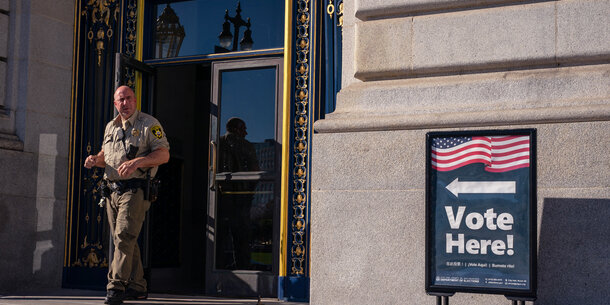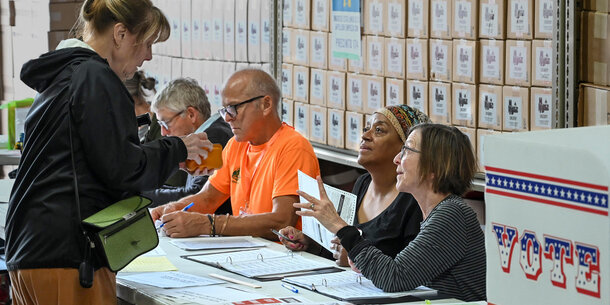A state senate hearing about New Yorkers’ recurrent voting problems set for July 28, in Brooklyn, no doubt will elicit testimony about the New York City Board of Elections’ notorious dysfunction. Most recently, the agency wrongly included approximately 135,000 test ballots in an early vote count for the mayoral primary. That mistake was just one in a history of often more serious failures — from illegally canceled voter registrations to hours-long lines to malfunctioning machines — that have disenfranchised thousands of New Yorkers and demoralized many more.
Why do these problems keep happening? Next month, the Brennan Center will release a report that finds many of these failures stem from the agency’s exceptional insularity, which breeds inefficiency, blocks accountability, and hampers professionalism and innovation. Some of that insularity can be attributed to the state constitution, which gives the two major parties a direct role in nominating the board’s commissioners. But the state legislature, whose laws govern the city’s Board of Elections, need not wait to improve the agency’s performance until the constitution is amended — a process that takes two legislative sessions and a ballot referendum.
To the contrary, we find there are major changes that state lawmakers can and should enact now to create public accountability, improve leadership, and mandate best practices that have been widely adopted by large jurisdictions around the country. The following preliminary recommendations from the Brennan Center will bring urgently needed advances to the city agency, which serves 5.5 million voters, more than in most states.
Reduce the number of commissioners from 10 to 4. The New York City Board of Elections’ leadership is far larger and more diffuse than that of any other major metropolitan elections agency in the country, causing inefficiency and obscuring accountability in a system already dominated by party insiders. The 10-member board comprises two commissioners, a Democrat and a Republican, from each of the city’s five counties. Of the nation’s 15 largest elections jurisdictions with multimember boards outside of New York, all except one have three to five members (none have more than six), and they are not selected based on geographic subdivisions.
The difficulty of reaching a six-vote majority in an institution in which commissioners micromanage operations, including hires, encourages inefficiency. The multiplicity of seats of power both enables and obscures excessive county party influence in operations meant to serve all New Yorkers. Decreasing the number of commissioners would increase efficiency and accountability, and make voter service more equitable citywide. (The board should retain its local borough branches to serve voters.)
Require the local appointing authority, the New York City Council, to conduct a transparent, merit-based process for selecting commissioners. Many mistakenly assume that the state constitution gives unaccountable county party insiders control over the selection of commissioners. Instead, the current process — in which county party leaders nominate commissioners, who are inevitably rubberstamped by the City Council — is primarily the product of state law, which can be changed. Even without a change in state law, the City Council can and should begin holding public confirmation hearings of nominees, something it did only for the first time in 2014 and has rarely done since.
The constitution states only that election “boards and officers” be selected on the nomination of “such representatives of [the two major] parties respectively, as the legislature may direct.” Nowhere does it mandate that control by local party leaders is necessary to meet that requirement. In other states where local parties nominate candidates for election boards, like Virginia, they suggest multiple candidates from which the appointing authority chooses. Nor does New York’s constitution prevent the City Council from requiring nominated candidates to demonstrate experience in election administration or voting rights, imposing term limits for commissioners, or conducting the selection process in public — all conditions that state lawmakers can and should establish.
Give locally accountable elected officials the power to remove commissioners, with review by the courts for just cause. While the City Council appoints commissioners, state law gives the governor the sole authority to remove them, a disconnect that is a major flaw in the accountability structure that governs the city’s Board of Elections. No governor has ever exercised this power, in spite of the agency’s extensive track record of poor leadership. Meanwhile the agency can dodge accountability to the city’s voters because their most direct representatives — the mayor and City Council members — lack meaningful oversight authority. This structure makes New York City an outlier among the largest jurisdictions with appointed boards, nearly all of which give appointment and removal power to the same entity. In addition to the governor, the mayor and city councilmembers should also have removal authority, subject to approval by the courts to ensure just cause.
Require the board to publicly advertise vacancies and conduct national searches to hire top executive staff. Other elections agencies serving large populations, including those in Los Angeles and Maricopa County, Arizona, conduct national searches in order to recruit the best qualified executive staff. As far back as 1988, editorial boards, governors, and mayors have urged this commonsense approach to finding top talent to lead New York City’s agency, but to no avail. Currently the board advertises only a handful of technical positions, making no information about the criteria or hiring record for other jobs readily available. Commissioners select nearly all hires from names suggested by their networks or by current staffers, a practice that seems inefficient for routine clerical functions and too insular for leadership roles.
Require that commissioners and executive staff complete election law and administration training. Other states where local boards administer elections, including Ohio, North Carolina, and Virginia, legislatively require board members to receive state training shortly after appointment and to periodically update their training. While New York law currently sets some training standards for poll workers and lower-ranked agency staffers, it does not require any for commissioners. Senator Liz Krueger and Assemblymember Nily Rozic have introduced a bill that would standardize training requirements for commissioners, executive leadership, and agency employees.
Strike the requirement in state law that all agency staff reflect equal representation of the two major political parties. Current law unnecessarily extends the state constitutional requirement of equal bipartisan representation in “boards or officers charged with the duty of qualifying voters, or of distributing ballots to voters, or of receiving, recording or counting votes at elections” to cover all Board of Elections staff. This requirement has enabled the board to insist on inefficient duplication of most every nonmanagement role at the agency — such that most functions, no matter how routine, have two staffers — and has exacerbated patronage hiring.
Require the agency to track and publicly report key voting and elections administration data in an accessible, frequently updated form. Adequate data tracking and public reporting are important to keep election agencies accountable to voters, inform efficient and responsive administration, and enable outside experts to evaluate performance and recommend improvements. Currently the board publishes little detailed data, without frequent updates and most typically in a difficult-to-use PDF format. Other large election jurisdictions, such as Cook County, Illinois, and Orange County, California, release more comprehensive, interactive data through publicly accessible, user-friendly databases that allow even novice researchers to gain a better understanding of elections in their community. State Senator Zellnor Myrie and Assemblymember Latrice Walker have introduced a bill that, among other reforms, would create a public statewide database to track voting population and demographics by election district, voter registration lists and history files, poll site locations, and other metrics — a promising basis for modernizing election administration.
These reforms would vastly improve the New York City Board of Elections’ accountability and service to voters, but they do not preclude deeper structural changes that may be needed — in New York City and elsewhere in the state — to fundamentally transform a state election administration system that has failed voters repeatedly. For instance, a shift to independent election administration, rather than a system controlled by the two major parties, would require amending the state constitution. But implementing these recommendations, and the nationwide best practices that inform them, would significantly improve election administration, both under the current constitution and after an amendment process.



